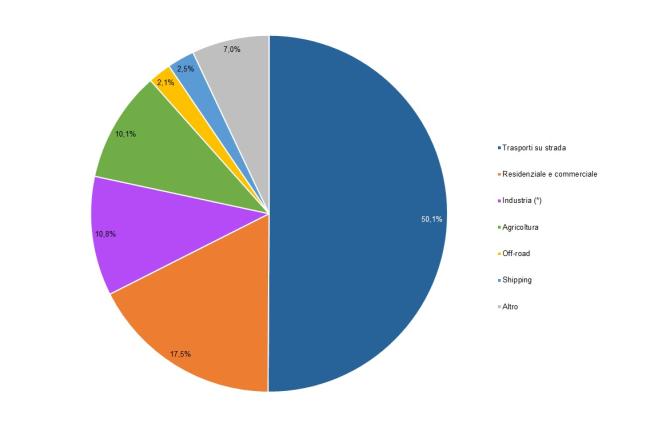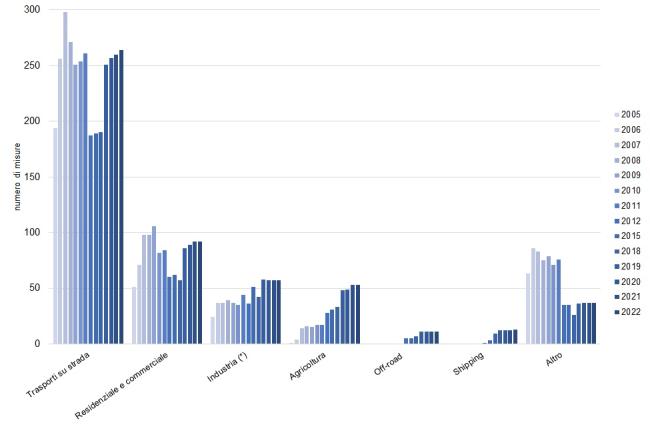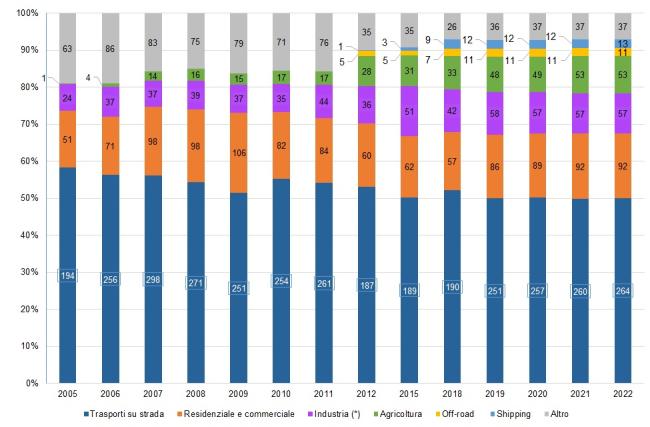Panel 1
Mariacarmela Cusano
The indicator is based on information related to air quality plans which, according to Directive 2008/50/EC (and its national transposition, Legislative Decree 155/2010), must be adopted in case of exceedances of the limits set for major air pollutants.
At the national level, information on air quality plans, communicated by the regions and autonomous provinces in the format required by Decision 2011/850/EU, is collected and stored by ISPRA in the InfoAria database, and subsequently transmitted to the European Commission (EC) "within two years of the end of the year in which the first exceedance was observed" (Directive 2008/50/EC, Article 23).
This information does not need to be transmitted annually, but only when new elements are to be reported. Therefore, both the information submitted in 2024 and the data provided in previous years by regions/autonomous provinces that were not required to submit new data are analysed.
The analysis shows that the measures reported in 2023 (adopted following exceedances recorded in 2021) and those previously submitted and still in force total 517, of which 50% fall within the Road Transport sector and 17% within the Residential and Commercial sector.
The above-mentioned analysis shows that the measures reported in 2024 (adopted following exceedances of limit values recorded in 2022), together with those submitted in previous years and still in force, amount to a total of 527. Of these, 50.1% fall within the Road transport sector and 17.5% within the Residential and commercial sector.
The indicator is based on information regarding air quality plans that regions and autonomous provinces (authorities responsible for air quality management and assessment in Italy) must draft and implement pursuant to Legislative Decree 155/2010 (Article 9)—which transposes Directive 2008/50/EC—and its amendment, Legislative Decree 250/2012, in cases where the limit values set for atmospheric pollutants are exceeded. These pollutants include sulfur dioxide (SO₂), nitrogen dioxide (NO₂), benzene (C₆H₆), carbon monoxide (CO), lead (Pb), particulate matter PM₁₀ and PM₂.₅, and/or the target value (TV) established for ozone (O₃).
At the national level, the regions and autonomous provinces report information on regional/provincial air quality plans to the Ministry of the Environment and Energy Security (MASE) and ISPRA, using the format set by Decision 2011/850/EU, within eighteen months from the end of the year in which the exceedance was first recorded (Legislative Decree 155/2010, Article 19). At the European level, each Member State must transmit this information to the European Commission (EC) “within two years from the end of the year in which the first exceedance was observed” (Directive 2008/50/EC, Article 23).
Current legislation thus provides that information on air quality plans is not to be submitted annually but only when new elements are to be reported, such as a new or updated plan.
An air quality plan is the result of a process that, through territorial characterization, identification of specific emission sources (emissions inventory and related projections), air quality assessment, and the development of emission and air quality scenarios, leads to the identification of "additional" measures—beyond those already in place at the national and regional level—aimed at improving air quality.
With regard to ozone, prior to Directive 2008/50/EC, information on plans or measures adopted in response to exceedances of the target value (TV) was transmitted to the EC through a report (Directive 2002/3/EC, Legislative Decree 183/2004) which merely included a link to the plan or measures, making it difficult to use the information effectively. Since 2012, the reporting format for plans/measures regarding O₃ exceedances has been that set by Decision 2011/850/EU (Annex II, Parts H-K). As ozone is a fully secondary pollutant, whose main precursors are nitrogen dioxide (NO₂) and volatile organic compounds (VOCs), the reported measures (in the rare cases they exist) to reduce ozone concentrations essentially aim at reducing ambient air concentrations of these precursors.
rovide information on the measures implemented by regions and autonomous provinces to ensure compliance with the air pollutant limit values established by legislation
- Directive 2008/50/EC transposed at national level by Legislative Decree No. 155/2010, as amended.
-
Decision 2011/850/EU.
Directive 2008/50/EC on ambient air quality, transposed into national law by Legislative Decree No. 155/2010, as amended, requires compliance with the limit values for regulated air pollutants. Where these values are exceeded, the directive mandates the implementation of the necessary measures to achieve compliance within the prescribed timeframes.
Panel 2
ISPRA, Rapporti 254/2016, Piani per la qualità dell'aria: analisi delle nuove informazioni relative all'anno 2012
Data quality assessment
Autonomous Provinces, Regions
The data are collected and stored by ISPRA in the InfoAria Database, in accordance with the provisions of Directive 2008/50/EC (transposed into national law by Legislative Decree 155/2010) and Decision 2011/850/EU. The InfoAria Database is not publicly accessible.
Autonomous Provinces, Regions
2005-2022
Indicator assessment
The indicator is based on information related to air quality plans submitted by regions and autonomous provinces to ISPRA and the Ministry of the Environment and Energy Security (MASE), in accordance with the reporting format established by Decision 2011/850/EU.
Specifically, the indicator refers to the number of measures adopted within the framework of air quality management plans, and also provides information on the emission sectors targeted by these measures, including: Road transport, Residential and commercial, Industry (including heat and energy production), Agriculture, Off-road transport, Shipping or Maritime transport, and Other.
In 2024, 20 regions/autonomous provinces reported or confirmed information on air quality plans referring to the reference year 2022. The remaining region, which did not submit data, recorded exceedances only of the target value (TV) for ozone in that year.
The measures reported or confirmed in response to the exceedances recorded in 2022 amount to 522, the majority of which (50%) were implemented in the road transport sector (Figure 1).
With regard to the emission sectors affected by the measures reported for exceedances recorded between 2005 and 2022, the following trends can be observed (Figures 3a, 3b):
- The road transport sector accounts for the highest number of measures;
- Measures adopted in the road transport and residential/commercial sectors show a fluctuating trend up to 2018. This is likely due more to different reporting or aggregation approaches used by regions/autonomous provinces than to actual changes in the number of measures implemented in these sectors;
- Measures adopted in the industrial sector (including heat and power generation), as well as in the agriculture, off-road and shipping sectors, show a growing trend between 2005 and 2019, stabilising in 2020 and 2022. It is worth noting that in the reporting format prior to Decision 2011/850/EU, the off-road and shipping sectors were not explicitly considered among the relevant emission sectors, which is why they are only represented from 2012 onward;
- Measures for which the relevant emission sector is not specified, labelled as “Other”, show a sharp decrease in 2012, remaining relatively stable in the following years. This trend is likely due to improved accuracy by regions/autonomous provinces in classifying measures by emission sector.
Data
Table 1: Information on air quality plans submitted by regions and autonomous provinces in accordance with current legislation
Processing by ISPRA based on data provided by regions and autonomous provinces
SI – Information on the air quality plan submitted
(SI) – Previously submitted information on the air quality plan confirmed
Sia – The information submitted by the Apulia Region refers only to the measures adopted for exceeding the daily limit value (LV) for PM10, but not for the exceedance of the annual LV for NO₂ and the target value (TV) for O₃
NO – Information on the air quality plan not submitted, despite exceedance of at least one of the regulated pollutant limit values
* Exceedance only of the ozone target value
** No exceedance of the limit values for SO₂, NO₂, CO, PM10, PM2.5, and benzene, nor of the target value for ozone: Air quality plan not required
# Lack of information on air quality assessment
## Lack of information on air quality assessment for ozone
Figure 2: Distribution of air quality improvement measures communicated or confirmed by emission sector, broken down by region/autonomous province(2022)
Processing by ISPRA based on data provided by regions and autonomous provinces
(*) = including heat and power generation




In 2022, twelve regions and the Autonomous Province of Bolzano exceeded at least one of the limit values for regulated air pollutants. Five regions and the Autonomous Province of Trento recorded exceedances exclusively of the target value (TV) for ozone, while two regions did not report any exceedances of limit or target values (Table 1).
Until 2011, information was reported for all regulated pollutants (excluding ozone) using the format established by Decision 2004/224/EC. For the years 2012–2022, reporting followed the format laid down in Decision 2011/850/EU (Annex II, Parts H, I, J, and K).
With reference to data reporting for the year 2022 (Table 1):
Overall, a total of 527 air quality measures were reported or confirmed in relation to exceedances registered in 2022. As shown in Figure 1, the majority of measures (50.1%) fall within the Road transport sector, followed by the Residential and commercial sector, which accounts for 17.5%.
Figure 2 shows the distribution of the 527 measures by region/autonomous province, broken down by relevant emission sector.